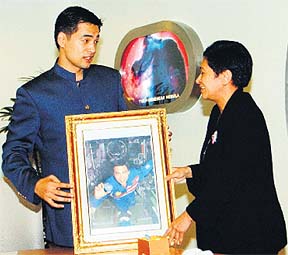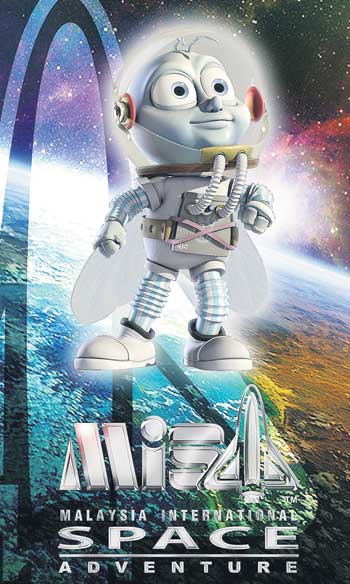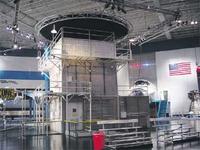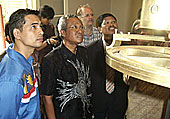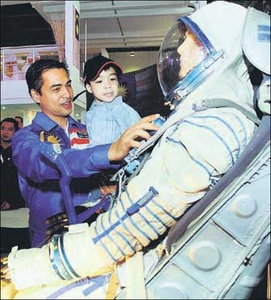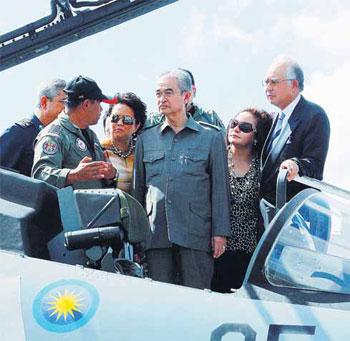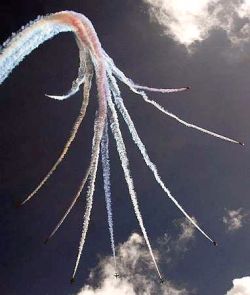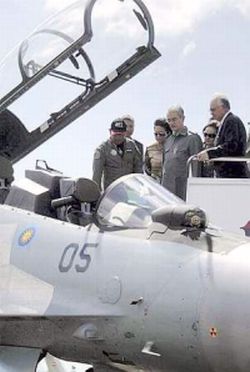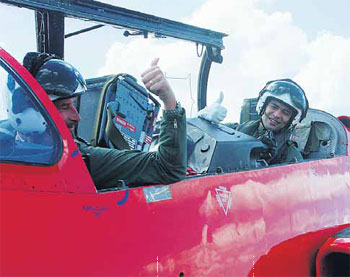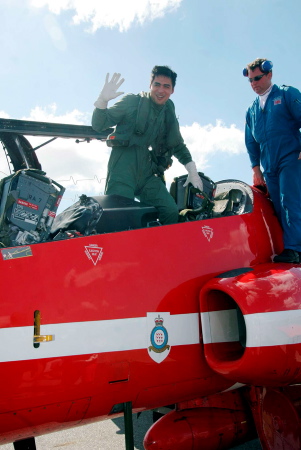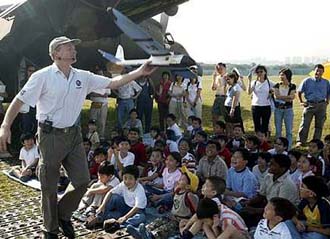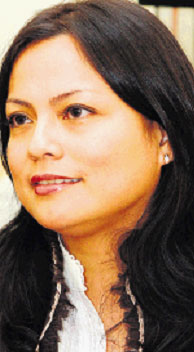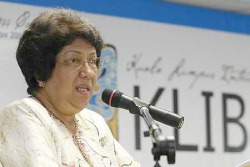ONE of the country’s most talented, accomplished and visionary women talks about efforts to get people interested in space science, writes ARFAH ABDULLAH.
ANALYSE her DNA and you will surely find a potent mix of 16th century seafaring explorer cum kris-wielding warrior with a touch of palace maiden running through her veins.
She finds uncharted territory fascinating, be it unexplored caves or a non-existent space science industry, and she will belt it into submission to create her vision. The odds? Inconsequential. For hers is the blood of a true pioneer.
Once a path is beaten, she will softly beckon for us to follow. Once we are settled in our new environment, she will take a bow, and leave for the next adventure on the road of perpetual discovery.
Having clocked out for the last time and walked out of the doors of the National Space Agency (Angkasa), its director-general Prof Datuk Dr Mazlan Othman will not look back, let alone come back.
She has pointed Angkasa firmly in the direction to sustain an active space science industry. Her 15-year technology, infrastructure, human capital and governance road-maps have been put in place. She retires with head, heart, soul and integrity intact.
And she is incredibly keen on her re-appointment as Director of the United Nations Office for Outer Space Affairs (Unoosa) in Vienna, a post she had held previously from 1999 to 2002.
"It was an incredible relief," says Mazlan, laughing when reminded of the tears of mixed emotion she shed during the moments of Dr Sheikh Muszaphar Shukor Sheikh Mustapha’s lift-off on Oct 10.
It gave her the closure she needed at the end of her own arduous journey that mobilised the angkasawan programme into action literally from thin air.
In building the Angkasa infrastructure, she has had so much pleasure working with the Economic Planning Unit, the Attorney-General’s Chambers, Treasury and Wisma Putra, all of whom were professional and "understand the strategic goals of our space programmes".
"Anyone can go to space," she admits "but the angkasawan programme was about creating value through science, through technology development, and overall awareness for science and space science."
"It is not just finished with the return of one angkasawan. It's about carrying on with the space science."
"That's why I have set up relationships with the European Space Agency, the Japanese Space Agency and NASA, so we can have long-term plans with them."
It was Mazlan who carefully negotiated to and fro with Moscow to find the optimum- cost solution for the scientific experiments which Dr Sheikh Muszaphar conducted on the International Space Station nine weeks ago.
"We had to make sure that our scope was big enough, but not too big that the Russians would charge a phenomenal amount," says Mazlan, adding that each gramme of payload placed on the rockets has a large monetary value attached to it.
She says that while a maximum of RM15 million was spent on co-ordinating the science experiments, the actual training of the angkasawan was gratuitous as a result of the Ministry of Defence’s Sukhoi offset agreement.
Angkasa spent RM10 million, including expenditure for negotiation activities in Russia and contract to the Russian Space Agency for science support. The biotech division under the Ministry of Science, Technology and Innovation gave RM4 million worth of research grants to Universiti Kebangsaan Malaysia (UKM), Universiti Teknologi Mara (UiTM) and Universiti Putra Malaysia (UPM).
"For the science, we were always very careful and cognisant of the fact that we were spending taxpayers' money. However, I cannot tell you how much it cost to hold the live telecast or organise the media and logistics, because I don't know."
She does know that the results of the three science experiments that were carried out in space by Dr Sheikh Muszaphar were worth the anticipation.
"We expect commercialisation from the science itself, like the protein crystals which are still being analysed."
"Alas, we are not able to commercialise any technology from the project. We did not build the rockets, we did not build the chair, we did not invent the space suit. There was no transfer of technology, although there are plans for it now."
Spacecraft technology is the most difficult to acquire because "it is the same technology used to launch warheads and ballistic missiles, so the restrictions against exporting such technology are great". The investment cost is expected to be equally as great.
So, is building our own rockets on the agenda or not?
"I think it is a male thing to want to build rockets," she laughs.
"It doesn't have to be top priority right now. But you can do it, with a detailed and sound strategic plan."
"You could leapfrog some of the technologies and buy some components. If it's okay not to have the entire engine designed by us, then yes. If our aim is to get a certain amount of technology transfer for fuel technology and engine technology, then yes."
"Technology transfer sounds good but it can only happen when the gap is narrowed. When the gap is too big, there is no transfer. It will be just like teaching a theory."
Now that Angkasa is five years old, Mazlan is confident she has sown the seeds for the next phase of its life.
"It is now a question of management."
To feel sad about her departure is not to understand the psyche that makes up Mazlan. Creating something out of nothing, and then moving on, has always been her approach to life, work or play.
First, her choice to do astrophysics was not a conventional one.
She started lecturing at UKM in 1975, gained her PhD in 1981, but still had to carve a place for courses and laboratories in the field. She managed to insert elements of space science into the school curriculum in 1990. Then she took a bow.
At the end of that year, she project-managed the National Planetarium which was opened in 1993 and embarked on public and school programmes. Here, she took another bow.
By 1994, she founded the Space Science Division (Baksa) and initiated the National Microsatellite programme. TiungSAT was completed in 1997, launched in 2000 and provided us with our own images of Earth and space. That’s her third bow.
With her leadership, government-owned Astronautic Technology Sdn Bhd was formed in 1997 and the company spearheads space technology development through RazakSat — the latest and most advanced satellite. Did she bow? Of course.
By now, she was wooed by the United Nations, so she left the country to serve as director of Unoosa in 1999. Before she could even take a bow, then prime minister Tun Dr Mahathir Mohamad requested for her return to set up and lead Angkasa in July 2002.
After she takes what she believes to be her final bow, but which many are sceptical, she will return to the UN and handle unfinished business.
Particularly, she will take up the issue of countries which prefer to build their own remote-sensing satellites, with their own protocol and specifications and not allowing for a seamless system where everyone can obtain photographs or data from one source.
"If I use the French satellite, I have to use the French system. If I use another country's, it's another system. No one is co-ordinating all this," says Mazlan.
"I could just buy one system to access all satellites, but now I have to buy at least five systems. It’s expensive."
Her spendthrift ways have had an impact. Much of what Angkasa is today was also a result of her resourceful ways of cutting cost.
She attributes the pioneer in her to an intrinsic drive that has always wanted to be different, and by definition more exciting. Even in school, she remembers always making it a point to be interested in all things other than what her peers enjoyed.
Don't let her get started on her actual physical pursuits. She prefers climbing Gunung Tahan to Mount Kinabalu as it is more treacherous. She prefers being airlifted by helicopter to the most remote part of the jungle because it is untouched.
This spirit of adventure is shared with her husband (Prof Ibrahim Komo, deputy vice-chancellor of UKM) and they often go on expeditions together to look first-hand at the latest geological discoveries like dinosaur eggs for instance. Some are housed in glass cabinets in her home.
"Before the angkasawan programme, I could talk about satellites and rockets but the public did not feel a connection."
"This project is able to connect people with what is happening in space."
"People who would not normally talk about space have started asking questions. And whether what we are doing is good or not. It’s a healthy debate!" she says, adding that any kind of criticism is good as a guide to continuous improvement.
She admits that if she were to put her mind and channel her efforts towards something post-Angkasa in the country, it would be on how to produce Malaysia’s very first Olympic gold medallist.
"When we went into the angkasawan programme, I clearly thought of the type of person you need to have — someone with the mental tenacity, physical fitness, medical suitability and most importantly the psychological mindframe."
"It’s exactly the same if you wanted to train a group of people for an Olympic gold medal."
In the United States, third grade schoolers have a lesson called "Inventors and Trailblazers", where the innovations and efforts of legendary individuals are studied with particular attention being paid to how they overcame barriers.
A very likely candidate, if such a lesson was introduced in Malaysia, should be none other than Mazlan.


